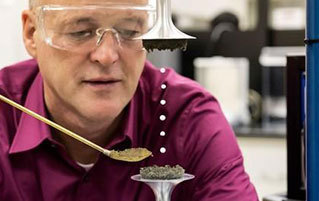5 Amazing Magical Powers Created by Simple Science

For the most part, the old alchemists and magicians were fooling their audiences with plain ol' science. If you knew nothing of chemistry, the sight of water turning instantly into oil would seem like witchcraft.
But even for us jaded modern types with our fancy "education" and "skepticism," science can do things that not only seem like magic, but make magic tricks look like a bunch of ridiculous bullshit.
You Can Make Objects Look Possessed Using Vibrations

As awesome as the concept of telekinesis is, it's remarkably hard to do, and if you pull it off, the government will almost certainly hunt you down and/or force you to join a team of crime fighters. Pretty much every "He's moving things with his miiiiind" trick is easily explainable as either sleight of hand or some neat physics cheat code.
But where magicians fail, science delivers -- here's a handful of sand, moving by itself and forming patterns like it's practicing the halftime show for the Super Bowl:

Later in the video someone spills beer on the sand and it starts drawing dicks.
And here are some drops of water calmly ignoring all laws of physics and walking on the surface of a pool:

All the more reason to never pee in the pool.
Science's much more awesome version of this trick is done with vibrations. That masterful sand dance is just a day at the office for cymatics researchers, who study visible vibrations and how frequencies relate to geometric patterns. The higher the frequency, the more complex these sound-shapes get.

Five down and dead center: dicks, courtesy of Science.
It's the same thing with the water trick: Putting speakers under a water container makes the fluid vibrate and causes small droplets to bounce on the surface indefinitely. Boom up the bass, and they'll happily cluster and bob along until the vibrations end. Then the party's over, and the drops become boring, normal water again. Scientists call these wandering droplets "walkers" and use them to study the dual relationship of particles and waves.
However, you're not going to be dazzled by mere water and sand. You want science to really impress you. So let's see what the vibration trick looks like with some non-Newtonian oobleck fluid:

It's like a T-1000 had a wet dream.
Apparently, all it takes to create an angry, sentient blob monster is cornstarch, water, and dubstep.
Instantly Shrink Coins With Magnetism
This is what appears to be a totally unremarkable picture of two coins:

Man, Tiny George has a jawline.
Yep, that's clearly just a normal quarter, next to a strangely misprinted dime that may or may not have been carved into existence by a man who has started a counterfeiting business to finance his vision-impairing meth addiction. But despite the fact that the coin on the left is basically Arnold Schwarzenegger to the right one's Danny DeVito, these quarters are actually twins. (Man, someone should make a movie out of that concept.)
But while the Incredible Shrinking Penny is an entry-level magic trick that's probably as old as pennies themselves, with the aid of some hardcore electromagnets, science has found a way to shrink-ray coins to a fraction of their size for real. Oh, and the whole shrinkage takes less than a second:

*Schluppp!*
This wonderful madness is the end result of a process called electromagnetic forming. It's a wire coil rig that can shrink -- or rather condense -- metal objects in the blink of an eye using powerful magnetic fields. The currents involved are massive, and the fields are arranged so that they repel each other, leaving the coin trapped in the push and pull of powerful electromagnetic forces. With enough power, the coin starts re-forming inward, becoming smaller and denser:

We're not sure the tiny versions retain their value, but they do sting like crazy when thrown off a bridge.
Unfortunately, as the effect is based on magnetic fields, you can only do this to metal objects. This leaves Ant-Man style shrinking powers a potential possibility only for Wolverine and cyborgs. Still, it's probably for the better, seeing as this is what happens when the process is applied to objects that aren't as sturdy as coins:
Bismuth Will Make You Look Like an Alchemist

Since Uri Geller made bending spoons popular in the 1970s, magicians have often claimed that they can shape metal with their will, despite the fact that the trick has been thoroughly debunked. (Spoiler: He pre-bends it manually.)
Still, that doesn't mean you can't do ridiculously impressive tricks with metal. You just need to pick the right metal -- namely, bismuth. Treat it well and it responds by turning into this:

Joseph's sex toy of many colors.
The object above may look like it broke off a carnival float in Rio de Janeiro, but it's actually just an ordinary bismuth crystal, and it's so easy to make, it's a small wonder Geller hasn't claimed the trick for himself. Here's a guy cooking up a batch of these crystals, just melting the stuff on his stove top and cooling it down while moving the mass around every once in a while.
When bismuth is heated past its melting point and cooled back to a temperature where it starts to solidify, its atoms lock into unique, geometrical structures, resulting in a phenomenon known as "bitchin' shapes." You can see them forming here:

Beautiful complexity often begins by looking like crap boiling on a hot car hood.
Those crystals take shape in a matter of minutes -- the metal just spontaneously starts forming elaborate stair patterns and oxidizing into awesome colors, because it's bismuth and it damn well can. The end results of this phenomenon are amazing constructs like this:
And this:

You just know David Bowie is hiding in there somewhere.
Although it's possible for bismuth to form its crystals naturally, it hardly ever does that because the metal rarely encounters its melting point in nature. And that's the most wonderful thing about bismuth, really -- it has basically just been lying around for us to find, figure out, and sell as jewelry on Etsy.
Glowing Organisms Are Easy to Make (for a Scientist)

You know those glowing magic fingers you can buy for a few dollars to "amaze your friends" with? So do scientists, and they would not be seen dead using one of those. Luckily, they don't need to, because they have already made the very concept of photoluminescence their bitch. Here, Johnny Glowfinger, have a goddamn kitten that glows in the dark:

Or Lex has come up with the most adorable way to kill Superman yet.
Yes, that's a real animal, and yes, we have taken millions of years of evolution that created this nocturnal animal and thrown it all out of the window because we wanted to make it shine. In science's defense, this is not just to make that kitty look cool -- the glow is a product of a gene splice that helps researchers study and fight feline AIDS. It's not all they're doing at the make-stuff-glow laboratories, either: Among other things, scientists are also creating plants that they hope to use as streetlights and glowing rabbits that may one day be used as biological medicine factories.

"What do you say now, Mr. You-can't-water-a-plant-with-nothing-but-Mountain-Dew?"
Making plants glow is actually surprisingly easy: Inject some fluorescent dye, stick the plant under an ultraviolet light, and bam! Glow-in-the-dark flowers.

Just don't try to impress any bioluminescent women with a lame ol' glowing carnation.
Of course, hardcore scientists prefer to create their nightlights with less luminescent injections and more gene tinkerin'. A few natural bioluminescence genes from a jellyfish in mammal DNA creates a glowing cat surprisingly easily. And while it may seem like a pretty strange thing to do, it's kind of hard to be against something that aims to cure cat AIDS, which is the most depressing freaking thing we've heard all week.
You Can Levitate Anything With the Right Gear
Levitation is probably the most impressive of magic tricks, which is why it's the go-to bit for everyone from David Blaine to Yoda. There are tons of ways to perform the trick, from wires to Balducci levitation to Criss Angel's ridiculous, yet surprisingly effective fake foot and a box version. The scientific variation on the theme seems equally easy to figure out: It's magnets, right? Everyone knows you can make things levitate with magnets. That's literally what the term "maglev" means, for crying out loud.
And then we see this goddamn thing, tilted in a way that the magnet it's floating above could never cause:

Ghosts?
Then there's this little object, just calmly flying circles under a table like a miniature UFO, rebelling against the pull of the Earth so hard that it's painting graffiti on the ground as it goes:

"Fuuuuuckkkkk yoooooouuuu, Baaaaannnnkssssyyy!"
And finally, here is some totally non-magnetic liquid, just floating around like it ain't no thing:

Meanwhile, you can't eat a meal without turning your shirt into a Jackson Pollock ripoff.
Those tilted and hanging objects are indeed made possible by magnets, but with a quantum twist. Quantum levitation is achieved when scientists cover an object with a thin layer of a superconductor that has been cooled with liquid nitrogen (which is why the thing in that gif is fuming and staining the ground). Superconductors naturally bend the magnetic field around them, but if the layer is thin enough, it lets some magnetism through -- enough to lock it in a state of magnetic levitation, while being allowed to move with relative freedom.
That levitating liquid, on the other hand, is the product of a non-magnetic technique called acoustic levitation. Align two loudspeakers vertically on top of each other, and when tuned up to the proper frequencies, they create a standing wave of sound between them. The sound waves from above and below cancel each other out, letting light objects just ride that sweet wave midair.

"Why do I suddenly want to play Pac-Man?"
Sadly, the minimum sound levels required for acoustic levitation are around 160 decibels, at a pitch that is as high as a dog whistle. Levitating bigger objects requires significantly louder sounds, so for now, the method is limited to floating lightweight stuff like water drops and toothpicks. Still, it's a beginning: All we need to do now is develop technology that enables us to withstand intense acoustic vibrations without instantly exploding in a mess of guts and shattered bone, and we'll finally be able to say goodbye to walking forever.
Meanwhile, here's a cool video of water and sodium locked in a levitating waltz:
"Beat this shit, David Blaine." -Science
You can find Steve doing awesome experiments turning letters into words in his Internet basement. Daniel has a blog, where he often creates "captured words."
Always on the go but can't get enough of Cracked? We have an Android app and iOS reader for you to pick from so you never miss another article.
Do you dream of designing T-shirts and rolling around in the dollar bills that result from that design? Because if you enter our latest T-shirt contest, that dream could come true. Post your terrifying re-imaginings of a cultural icons and you could win $500.
Related Reading: Modern science has also made quite a bit of black magic possible, including some straight up alchemy. Oh, and did you know water can explode all on its own? Well it can. For a scientific explanation of the tricks that freaked you out as a kid, read on.




